
Nutrition Biochemistry Dr. Ahmed
Nutrition
Nutrition is the science that deals with the relationship of food with the functioning
living organism
The nutritional requirements of a person are 3 fold:
1. Water.
2. Calories and
3. Specific molecules (Vitamins, minerals and oxygen).
WATER:
Water is more essential to life than is food, for a person may live weeks without food
but only days without water. It is an essential component of blood, lymph, the
secretions of the body and every cell in the body. More than ½ the adult’s weight is
water (60% for men and 54% for women) The extra cellular compartment account
for 1/3 of body water including plasma and interstitial spaces, while the intracellular
fluid contains 2/3 of body water. Fluid is necessary for the functioning of every organ
in the body. It is a structural component of cells, when a cell loses their water they
lose their shape. It is the universal medium in which the various chemical reactions
of the body take place.
As a carrier it aid in digestion, absorption, circulation and excretion. It is essential in
the regulation of body temperature. It plays an important part in mechanical
functions, such as the lubrication of joints and the movement of the viscera in the
abdominal cavity. Waste products from the tissues are transferred to the blood in a
watery solution, they are carried by the blood which is about 80% water and they
are excreted via the kidneys in urine (about 97% water).
The same water is reused many times and for different purposes .Approximately 8 L
of digestive juice are produced and secreted by the glands in 24 h. Over 4L of water
are always circulating in the blood stream. It is estimated that some 50 L of water
cross the cell membranes in a day.In the kidney large volumes of water (180L) carry
the dissolved waste materials through the capsule of the nephrones, most of the
Titles
Nutrition: definition
Water: Water intake and out put
Caloric requirements
Energy Contents of Food
Basal Metabolic Rate
Energy requirement
Objectives:
Principles of nutrition to be the
basis for more
detailed information of
nutrition and
to understand diseases
related to nutrition.

water, with some of its useful dissolved materials is reabsorbed (99%).The urine,
which is excreted, is the concentrated aqueous solution of the waste products.
Water intake and output:
Normally the body losses water through 4 routes; 1. From the skin
2.From the lung (Total about 800 ml)
3.From the kidneys (1-1.5L) and
4.From the intestine (about 200 ml).
Large amount of water are also lost in abnormal conditions including; fever,
vomiting, burns and hemorrhag. Fluids are replaced by the ingestion of liquids and
foods containing water. Although some water is formed within the body as an end
product of food metabolism.From 1-1.5 L of water or other liquids should be
consumed daily in order to insure a sufficient amount of water for body functions.
Caloric requirements:
The caloric requirement of man may be discussed in terms of protein, lipids, and
carbohydrates. These complicated organic substances are synthesized by the plants
from simple inorganic materials such as CO2, H2O, NH3, SO4 etc. Animals and
human get their energy from the food, which is derived directly or indirectly from
the plants. Energy taken as food is used for the following purposes: 1. To perform
mechanical work.
2. To maintain the tissues. &
3. For growth.
Energy Contents of Food:
It is found that 1 g of protein will give approximately 5.4 Kcal. Of heat, while 1 g of
fat will give approximately 9.3 Kcal. And 1 g of carbohydrate will give approximately
4.1 Kcal and 1 g of ethanol gives 7.1 Kcal of heat. It is known that a calorie is the
amount of heat or energy required to raise the temperature of 1 g of water 1 °C.
Some times the joule replaces the calorie as 1 calorie is equivalent to 4.184 joules.

Basal Metabolic Rate:
1
.
When a subject is at complete rest and no physical work is being carried out
energy is required for the activity of the internal organs and to maintain the
body temperature constant. This energy is called the basal metabolic rate or
Resting metabolism.The BMR is determined experimentally when the subject
is lying down at complete physical and mental rest, wearing light clothing, in
er the last meal.
a room comfortably worm and at least 12 h aft
Energy requirement:
There is a wide variation in the energy requirements of individuals, even of
those having same occupations and apparently living similar kind of lives. The
energy requirements of individual are dependent on four variables:
1-Physical activity.
2-Body size
3-age
4-Climate and environment.
Some references regard sex as another variable.There is also extra need of
energy for growth in childhood and adolescence and during pregnancy and
Physical Activity:
lactation,
About ½ of the energy expenditure of moderately active person is utilized in
maintaining the BMR or Resting metabolism. The rest is used by the muscles
in doing external work, mostly in moving the mass of the body and partly in
doing external work. The muscles also utilize energy in maintaining the
posture of the body.
Energy requirement:
Physical Activity
Body Size:
Age:
climate and Environment:
Growth and body size of
childhood and adolescence:
Pregnancy:
Lactation
:
Objectives:
1. To understand the body
requirements in normal condition
and in certain other conditions
2. To study the importance of
carbohydrate as a source of energy
and the special uses and benefits
of fibers in the diet
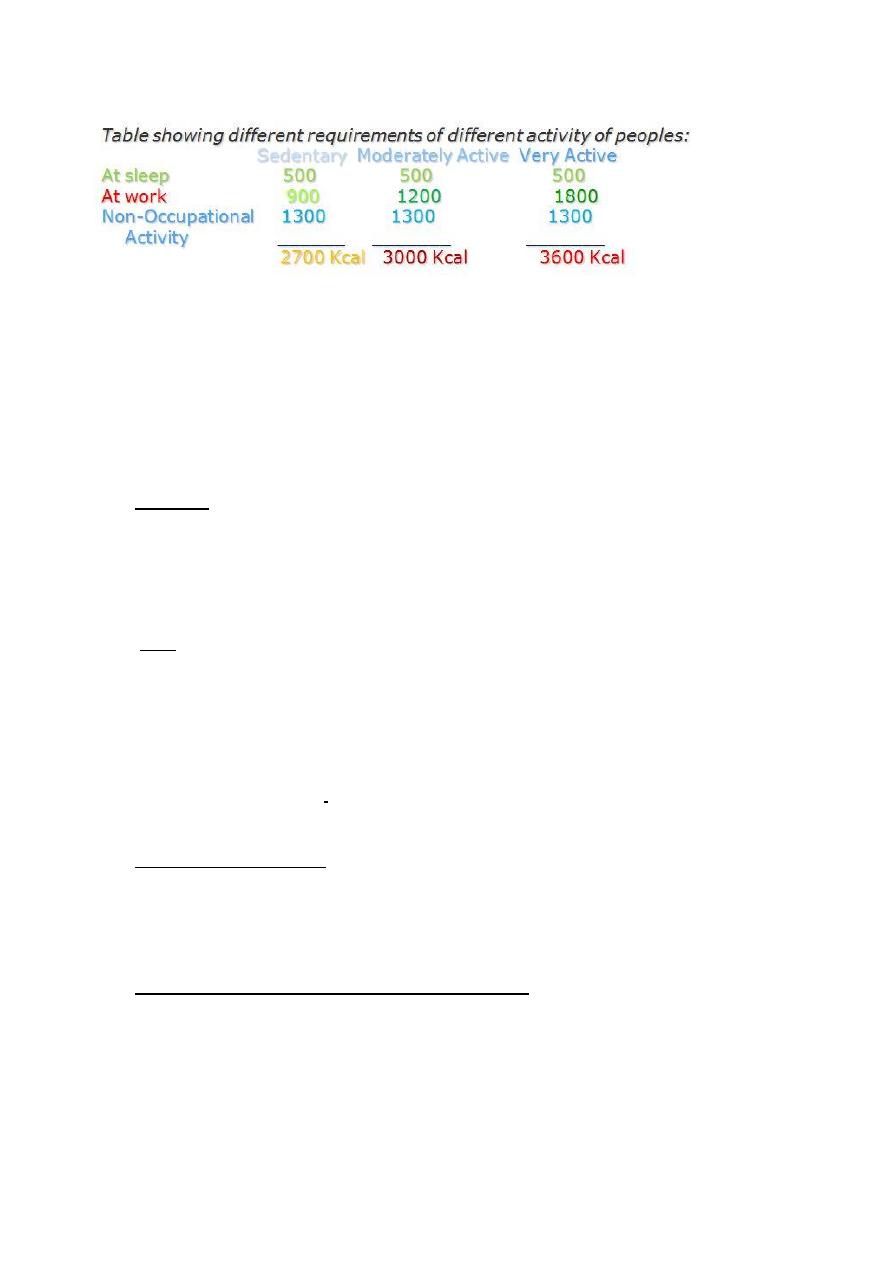
Example of sedentary occupations includes office workers, drivers, teachers,
journalists, doctors, lowers, students, and so on.
Examples of moderately active occupations include industry and railway workers,
postmen, farm workers and so on.
Examples of very active occupations include steel workers, builders and so on.
Body Size:
A tall man weighing 100 kg obviously needs more food than a short man weighing 50
kg There are many researches showing the relationship between body requirement
of energy and body weight and indicating that the big man require more calories
than a small man
Age:
.
Age affect energy requirements into 2 ways:
As people become older they tend to work in employment which requires a smaller
expenditure of energy and they reduce their physical exercise
The BMR per unite of body weight decreases slowly after the early twenties. This
decline with age is largely due to a reduction in the proportion of metabolically
sues in the body.
active tis
Climate and Environment:
It is a common opinion that cold weather stimulates appetite and hot weather
depresses it.
Any effect of climate is mainly due to changes in physical activity.but also the BMR is
some 10% lower in tropics than in temperate climates.
Growth and body size of childhood and adolescence:
The energy intake of children of different ages must obviously allow for satisfactory
growth and physical development and for the high degree of activity characteristic of
healthy children.The energy requirement per kg of child body weight is more than

double that of adult during the first year of life but falls slowly as the rate of growth
per unit of body weight falls with age.
Pregnancy:
During pregnancy extra energy is needed for the growth of fetus and the placenta.
Additional energy is also required for movements and activities when the mother
becomes heavier.
Lactation:
The quantity of breast milk produced by individual women varies widely. However an
additional dietary intake of about 500 Kcal/day during lactation is required,although
it is normal for a woman to lay down about 4 kg of fat during pregnancy and this
provides a reserve for use in lactation.
Carbohydrate in diet:
Carbohydrates are a major source of energy in the human diet; each gram of
carbohydrate provides approximately 4 Kcal. Although fat and protein can replaces
carbohydrate as a source of energy, however some carbohydrates are essential for
humans.Brain, nerve and lung tissues require glucose as their source of energy.
During hypoglycemia and when the brain deprived of glucose convulsion may
result.Carbohydrates especially sugars are converted to triglyceride in the liver and
become available to cell for energy or stored in the adipose tissues.Also during
transamination reaction intermediary products of carbohydrate metabolism can be
converted into amino acids and used for protein synthesis.
Carbohydrate in diet:
Fiber in the diet:
Protein in the diet:
Protein requirements:
Protein allowance:
protein deficiency :
Secondary protein
deficiency or
conditioned may arise
as a result of
pathological process
as follows:
Objective:
To understand the constituents
of each type food and its
importance in nutrition, and
To understand complications of
protein deficiency.

In agriculture societies the major portion of dietary carbohydrates is starch, while in
industrial societies, sugar provides a significant portion of the diet.
The substitution of sugar for starch in the diet may increase the plasma lipids in
some people.
This change is also mainly responsible for the high prevalence of dental caries and
may have contributed to the increased prevalence of
Diabetes,
coronary and heart diseases.
Fiber in the diet:
Fibers in the diet promote more frequent bowel movements and soften stool. Diets
high in cereal fibers have been shown to reduce the symptoms of diverticulosis, (a
disease of the large intestines). [Diverticulosis is a condition that develops when
pouches (diverticula )form in the wall of the colon (large intestine). These pouches
are usually very small (5 to 10 millimeters in diameter but can be larger].(cause
abdominal pain and irritable bowel) .] Persons who consume high fiber diets also
excrete more fats, sterols and bile acids in their stools and have been shown to have
lower blood cholesterol levels. Thus it has been suggested that the amount of fiber
in the diet may be a factor in the prevention of atherosclerosis.
It has also been indicated that the reduction of fiber in the diet may be a factor in
the increased incidence of cancer of the colon. New researches has indicated an
important function of fiber and that it delay hydrolysis of starchy food so give chance
to insulin to released so decreasing the incidence of diabetes.
Protein in the diet:
The nutritive value of protein depends on the proportion of the essential amino
acids in its molecule, although all amino acids are required for building of new
tissues. Protein is divided into animal and vegetable proteins.Animal proteins are
more important than vegetables as they contain larger amount of essential amino
acids.
Protein requirements
Protein requirements can be either; 1. The requirement for the essential amino
acids and 2. Requirement for the total protein; which must be available to the
body for the synthesis of non-essential amino acids.
Protein allowance:
It has been recommended a daily intake of 0.8 g of protein/kg of body weight for
adults. Hence the recommendation for a 70-kg male is 56 g of protein. An
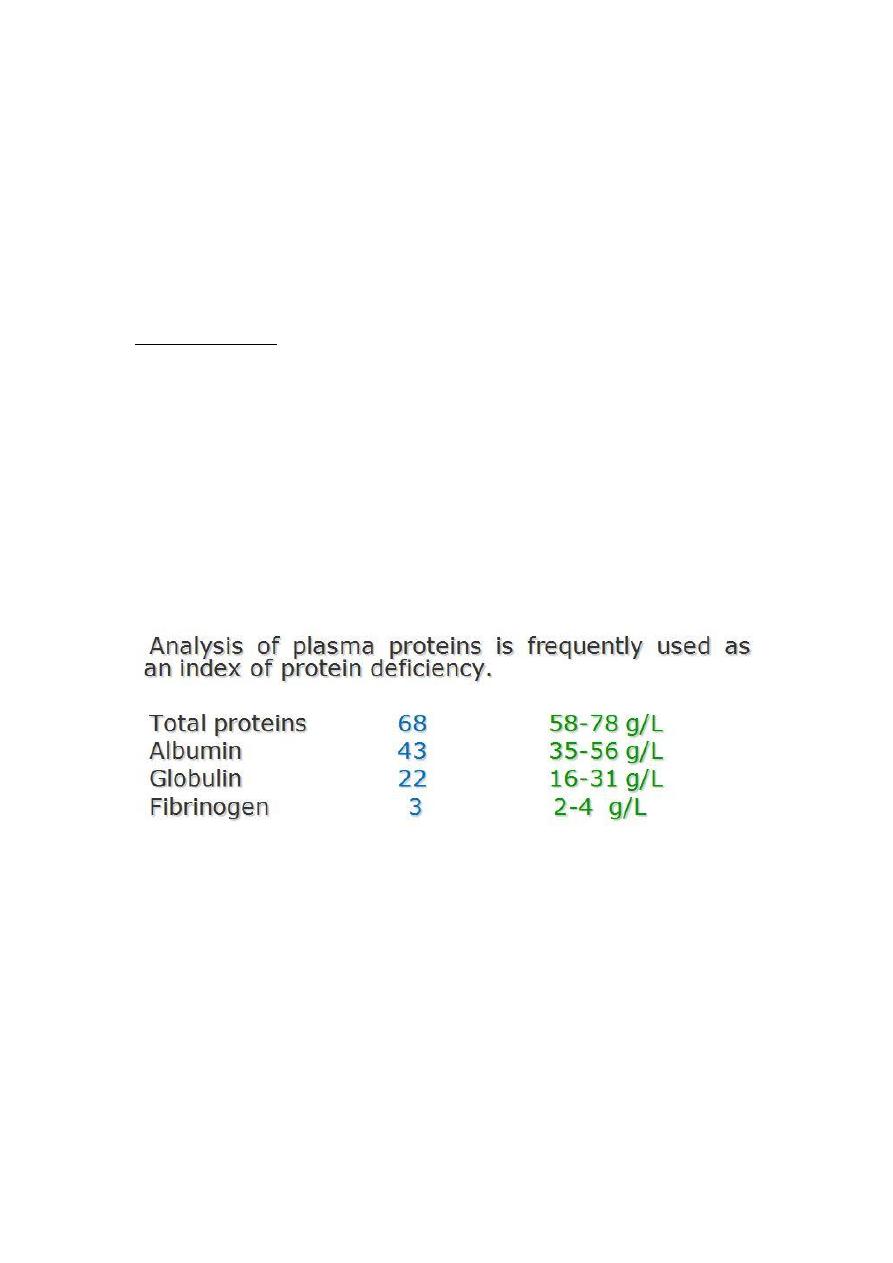
additional amount of protein to allow for growth has been included in the
allowance for children in the age group from 1-18 years. An additional 30 g / day
has also been added for pregnancy from the second month to the end of gestation,
20 additional grams is recommended during lactation to cover the milk produced.
It is highly desirable that at least 1/3 of the daily protein intake be derived from
animal sources. It is also necessary that some good quality proteins be included in
every meal.
Protein Deficiency:
If the dietary protein supply is insufficient, the cells lack amino acids for their
synthetic activities.The effect of this is clear in young child as growth slows down or
even stops. The effect of protein deficiency is also on organs and tissues of adults.
The first tissue affected by protein deficiency is the mucosa of the intestines and the
glands, which secrete the digestive enzymes, in consequence a failure to digest and
absorb the food leading to diarrhea and loss of water and electrolytes. Also failure of
the liver to maintained its normal structure and functions. In addition fat
accumulates in the liver cells, the liver also fails to synthesis plasma albumin and this
is liable to lead to edema.Later, protein deficiency leads
to a failure to maintain the structure of skeletal muscles and the production of RBCs
s muscle wasting and anemia results.
A plasma albumin concentration below 35 g/L means protein deficiency and in sever
deficiency states the level often falls to 15 g/L and some times lower.
The concentration of γ- globulin is often raised owing to the presence of infections.
A low plasma albumin and a high plasma globulin are frequently found together
where the people are poor with inadequate diet.
Secondary protein deficiency or conditioned may arise as a result of pathological
process as follows:
1. Utilization of protein as a source of energy, owing to an inadequate supply of
carbohydrate and fat.
2. Loss of protein in the urine as a result of diseases of the kidneys.
3. Loss of protein from the body by other routes such as hemorrhage or wounds.
4. Failure to absorb protein in various disorders of the intestine.

5. Failure of a damaged liver to synthesize protein particularly albumin from
amino acids absorbed from the intestines.
6. Damage to tissues (Trauma) e.g. injuries, burns, fractured bones or surgical
operations are followed by a period of negative nitrogen balance. (More
tissue protein is catabolic than the diets can immediately replace).
Fat in the diet:
The amount of fats in the diets varies greatly. In many rich countries fats usually
contributes 35-45% of the total energy, whereas in poor countries the figure is 15%
or even lower.
Since there is evidence of increased susceptibility to coronary heart diseases among
individuals with elevated levels of cholesterol &/or TG; attention is focused on those
food constituents which appear to affect the level of these 2 substances
(these are the total fat and sugar intake and the proportion of saturated to
polyunsaturated fatty acids and cholesterol).
However it is advisable to use diet-giving energy from fat of about 20%.
This is especially important if the person has reached middle age and it is important
to remember that it is healthier to substitute animal fat with vegetable oils in the
prevention and treatment of atherosclerosis.
Anyhow a high fat intake is necessary for very active people spending over 4000
Kcal/day.
On the other hand complex carbohydrate rather than Simple sugars should replace
the fat in the diet when weight reduction is required in order to reduce serum TG
levels.
So the foods selected will need to include more cereals grain, legumes, vegetables,
fish and vegetable oils and less animal fat and sugar.
Malnutrition:
Estimates indicated that there is a billion and half human in the world today
suffering from severe, moderate,or mild malnutrition.
Some children will die from malnutrition; larger number will suffer physical and
possibly mental retardation and will be more susceptible to infectious diseases.
Protein- Energy (Protein-calorie) malnutrition (PEM or PCM);PEM describe a
spectrum of clinical disorders .
At one end is Marasmus which is due to continued restriction of dietary energy and
proteins as well as other nutrients.
-Fat in the diet:
Malnutrition:
Protein- Energy
(Protein-calorie)
malnutrition (PEM
or PCM);
-Marasmus:
-Kwashiorkor:
Objectives:
-To complete the informations of the types of
nutritional components of the diet concerning
fats
-To understand the effects of deficiency of
calories and protein on human health specially
the infants and children and diseases related to
that including Marasmus and Kwashiorkor
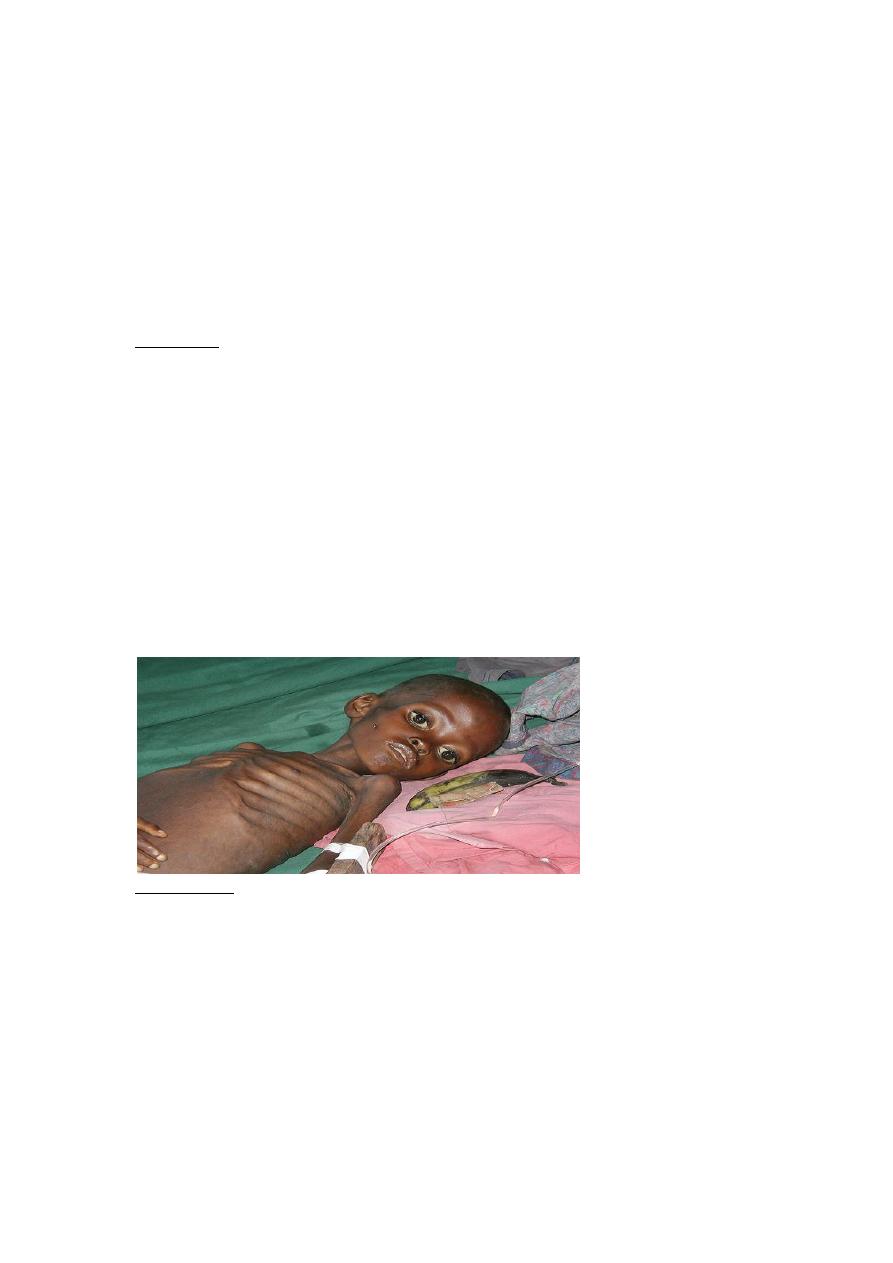
At the other end is Kwashiorkor, which is due to a quantitative and qualitative
deficiency of protein but in which energy intake may be adequate.
In between these 2 syndromes are forms in which the clinical features are due to
varying combinations of deficiency of protein and energy together with deficiencies
of minerals and vitamins and with associated infections.
PEM is the most important public health problem in underdeveloped countries in
the world today. It is largely responsible for the fact in many areas up to ½ the
children born do not survive to the age of 5 years.Death rates in these children may
be 20-50 times the rate in rich communities in Europe and America.
Marasmus:
Marasmus is more likely to develop in children under one year of age when breast
feeding fails or not continued for sufficient period of time, followed by dirty artificial
feeding with very dilute milk or milk products given in inadequate amount thus the
diet is low in both energy and proteins.
The infant with Marasmus is more than 40% below standard body weight. There is
no subcutaneous fat, muscle wasting and diminution of length is usually clear.
Edema is not noticeable .
The GIT is also affected and so watery diarrhea and bulky acid stool may be found
and if infective gastroenteritis is added the diarrhea is severe.
In addition the skin and mucous membrane are dry and atrophic.
The Marasmic infant looks like a little old man with a big head and huge eyes,
wrinkled face and tiny body.
Such infants are particularly susceptible to infectious diseases and their mortality is
high.
Kwashiorkor:
The name is African means the disease the older baby gets when the next one is
born.
In this case the presence of edema is clear. It is due to severe protein deficiency but
in which energy intake may be adequate. Kwashiorkor is an acute condition of short
duration in which recovery or death occurs relatively rapidly. The mortality rate even
among hospitalized children is high.The first and essential sign is the failure of
growth. The child’s skin shows dermatitis consists of areas of pigmentation and other
areas of depigmentation.

Ulcers occur over pressure points and deep cracks in skin folds.
The GIT is also affected and so watery diarrhea and large semisolid acid stool is
shown.
The muscles are usually wasted as a result many children regress in their physical
development.
Anemia is usually present and may be severe.
Some children have tremors resemble to Parkinsonism.
Treatment:
Specific therapy consists in providing the child with sufficient amount of protein and
energy and in controlling infection.
Milk is excellent for this purpose.
Many children can not tolerate whole milk, as diarrhea is increase (due to the
presence of fat).
So they are treated with skimmed milk.
Another problem with milk is its lactose content, as when the GIT is seriously
damaged is unable to produce lactase; this result in fermentation of lactose by
bacteria of the bowel and so diarrhea may increase.
In this condition a casein preparation must be used in addition to glucose as a source
of energy and few quantities of salt is also added.
Fortunately the digestive power improves rapidly with high protein intake.
Weight control is very important during life to prevent health
Weight Control:
problems associated with obesity. It has been observed that Diabetes Mellitus and
hypertension occur more frequently in obese individuals whose blood levels of
triglycerides and cholesterol are usually elevated.
Weight Control:
Obesity:
Causes:
Prevention:
Treatment:
Objectives:
To understand the problems when weight is not
controlled specially in rich countries, communities
or persons resulting in obesity. To understand
obesity its complications , causes and treatment
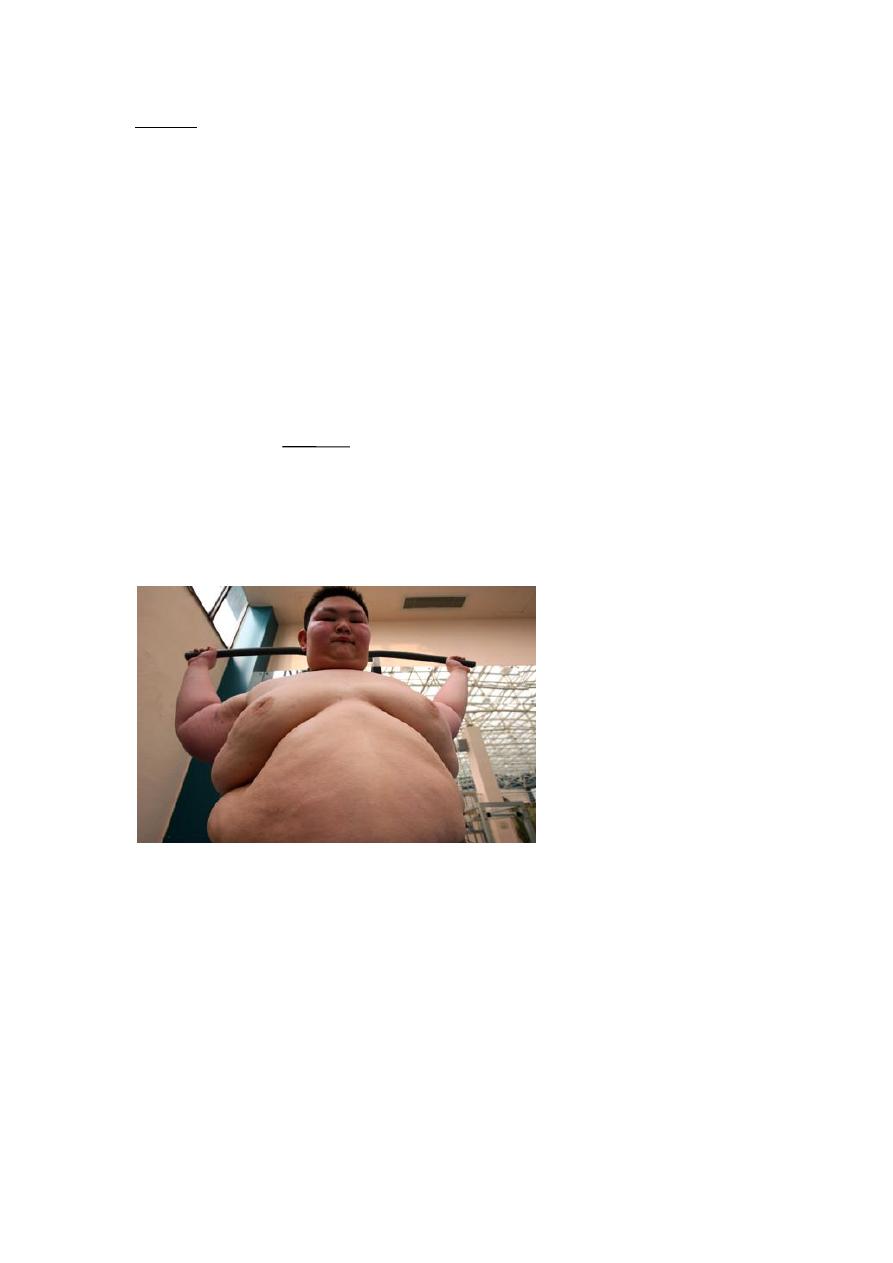
Obesity:
It is defined as the state in which an excess of fat accumulates in the body.
The proportion of fat in the total body weight gives a scientific measure of obesity.
Mean values of body fat for normal young men are about 12% and for young women
are about 26%.
A man regarded obese when the amount of fat increase more than 20% of his total
weight and a woman is considered obese if her fat increase to more than 30% than
the total body weight.
Obesity may be in both sexes but it is usually more common in women, it is specially
occur after pregnancy and at the menopause.
Now a days obesity index (Body mass index) is used on a large scale as an index of
obesity or over weight.
Weight (kg)
Obesity Index (BMI)=
2
Length in (m)
The typical result of this division range between 20-25. When the result is between
25-30 the subject has overweight, While when above than 30 it is obesity. However,
result less than 20 means underweight specially if less than 18
Causes:
1
.
1-Increased caloric intake, which exceeds the energy needs of the body
1
2-Change in living habits: As the habits in many countries have developed
from that of 50 years ago e.g.work hours have been shortened,
transportation is easier, the homes are well heated.
3
.
3- Emotional problems: Many people who are overweight eat because they
have nothing else to do.They may eat more when they are under stress or
when they feel unappreciated.
4. Activity: As obese person is less active than his counterpart of the same
age, this inactivity lower the caloric need of the body and in this way
contribute to overweight.

5. Endocrine: In small percentage of overweight individuals, the obesity may
be due to disturbances of functions of the endocrine glands such as thyroid
and pituitary.
Prevention:
Usually obesity starts in childhood and continues and increases in adult, so
early measures are indicated for the prevention of obesity.
One have to chick his weight in a suitable periods of time and when an increase
of weight is noted one have to limit or decrease some of the unnecessary food
such as sugars, cream, butter and others.
Also it is important to decrease food for every body at the late twenties and foreword.
At the same time an increase in the exercise such as walking and sports is
necessary.
Treatment:
1-By Food Control:
Since adipose tissues are stores for excess energy, then the calorie intake must
be below the actual daily needs and so one think to reduce the quantity of diet
taken to less than the actual need. Since carbohydrates and fats constitute the
greatest source of calories in the diet so they must be reduced,some prefer to
reduce fat to minimum and keeping normal amount of carbohydrate while
others prefer the reduction of both fats and carbohydrates equally.
2-By excise:
Exercise is required and it is very necessary to decrease weight or to burn the
energy.
One should follow a regular exercise or at least increase walking or swimming or
other sports.
3-By drugs:
a . Amphetamine and its derivatives:
They depress the appetite and stimulate metabolism and help to burn the excess
fat. However it has many side effects.
b. Thyroxin: It stimulates metabolism. This help in decreasing weight.
However it is contra indicated except in those rare cases of obesity associated
with evidence of hypothyroidism.
c. Methyl Cellulose:
This is indigestible substance add bulk to the diet it is a harmless substance.
d. Fenfluramin hydrochloride (Ponderax):
It decreases the felling of hunger in addition it helps in metabolizing food and
burns fats.
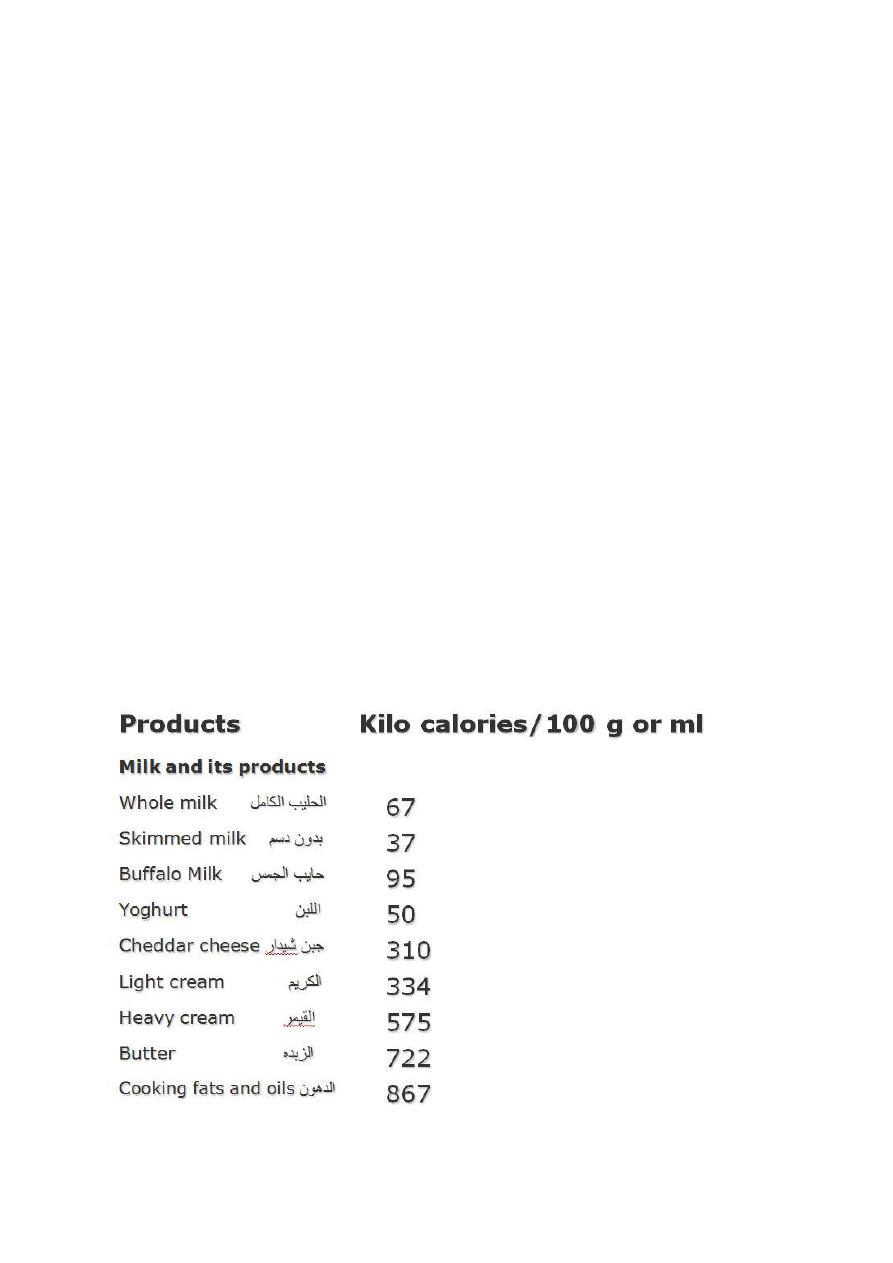
e. Mazindol (Teronac):
It is another drug for the treatment of obesity and it has similar effects to
Ponderax but has fewer side effects than Ponderax.
f. Orlistat (Xenical):
It is the latest drug used for the treatment of obesity. It is a specific and
reversible inhibiter of gastrointestinal lipases. Thus lipase become unable to
hydrolyze dietary fat in the form of TG
Underweight:
Weight more than 10% lower than ideal is usually considered to be abnormal
especially in persons less than 25 years and is usually require medical
investigation.
Under weight may be due to an inadequate energy intake or to excessive body
activity or it may be familial.
Diseases such as malignancy, G.I.T. disorders, chronic infectious diseases or
endocrine disturbances such as hyperthyroidism may be causes of progressive
weight loss.
Under weight due to an inadequate caloric intake may be a serious condition
especially in the young as resistance to infections particularly to TB may be
lowered .
Also the occurrence of the complications of pregnancy in young women may
result from malnutrition due to an inadequate energy intake.
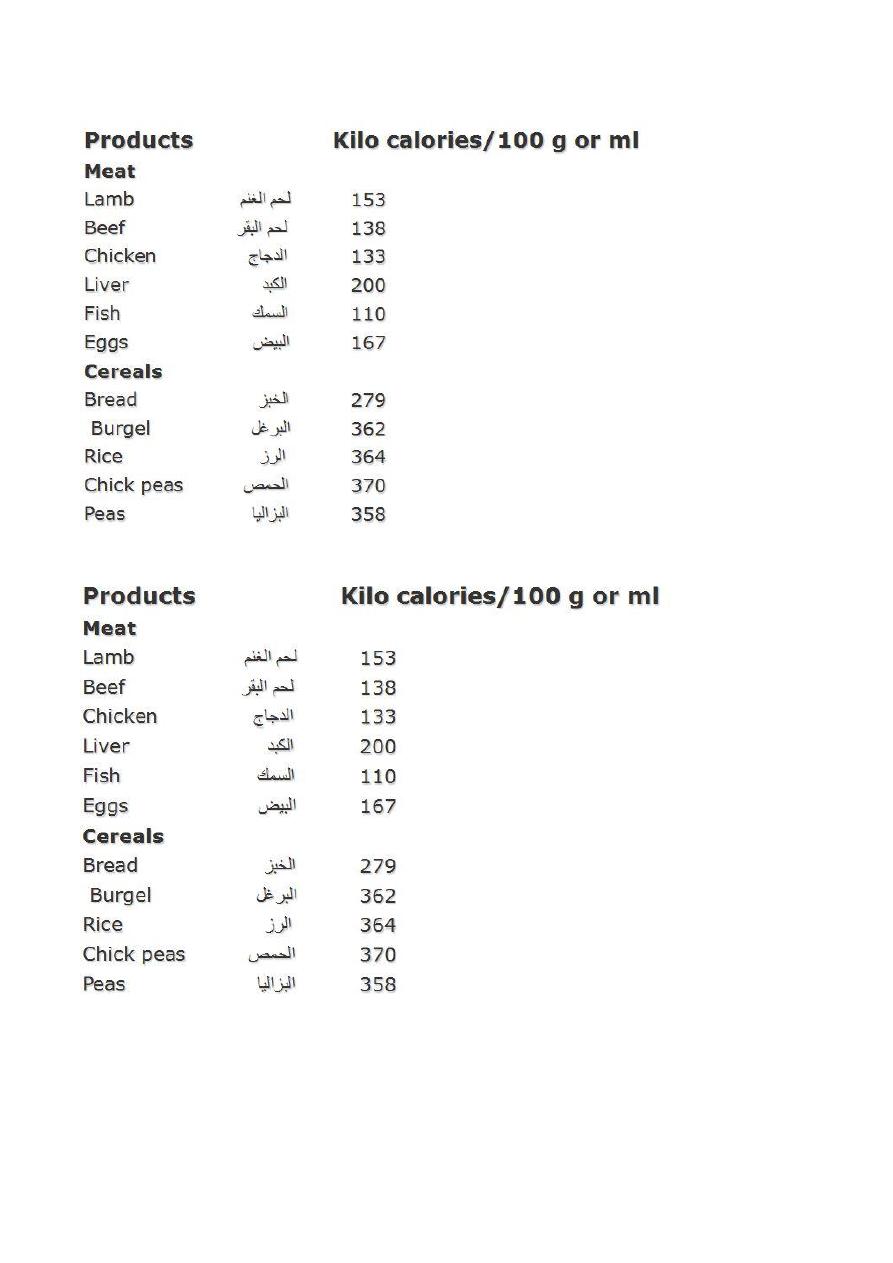

K
K
i
i
l
l
o
o
c
c
a
a
l
l
o
o
r
r
i
i
e
e
s
s
/
/
1
1
0
0
0
0
g
g
o
o
r
r
m
m
l
l
P
P
r
r
o
o
d
d
u
u
c
c
t
t
s
s
V
V
e
e
g
g
e
e
t
t
a
a
b
b
l
l
e
e
s
s
6
6
9
9
B
B
e
e
a
a
n
n
s
s
الباقالء
الباقالء
8
8
4
4
P
P
o
o
t
t
a
a
t
t
o
o
e
e
s
s
البطاطس
البطاطس
4
4
8
8
C
C
a
a
r
r
r
r
o
o
t
t
الجزر
الجزر
2
2
8
8
L
L
e
e
t
t
t
t
u
u
c
c
e
e
الخس
الخس
2
2
6
6
S
S
p
p
i
i
n
n
a
a
c
c
h
h
السبانخ
السبانخ
2
2
4
4
M
M
a
a
r
r
r
r
a
a
o
o
w
w
ال
ال
ش
ش
)جر
)جر
)
)
القرع
القرع
1
1
9
9
T
T
o
o
m
m
a
a
t
t
o
o
e
e
s
s
الطماطم
الطماطم
2
2
2
2
G
G
r
r
e
e
e
e
n
n
P
P
e
e
p
p
p
p
e
e
r
r
الفلفل األخضر
الفلفل األخضر
F
F
r
r
u
u
i
i
t
t
s
s
4
4
1
1
O
O
r
r
a
a
n
n
g
g
e
e
البرتقال
البرتقال
4
4
6
6
L
L
e
e
m
m
o
o
n
n
الليمون
الليمون
7
7
4
4
A
A
p
p
p
p
l
l
e
e
التفاح
التفاح
6
6
3
3
W
W
h
h
i
i
t
t
e
e
g
g
r
r
i
i
p
p
p
p
e
e
العنب األبيض
العنب األبيض
7
7
6
6
B
B
l
l
a
a
c
c
k
k
g
g
r
r
i
i
p
p
p
p
e
e
العنب األسود
العنب األسود
3
3
7
7
0
0
D
D
a
a
t
t
e
e
التمر
التمر
Thanks
